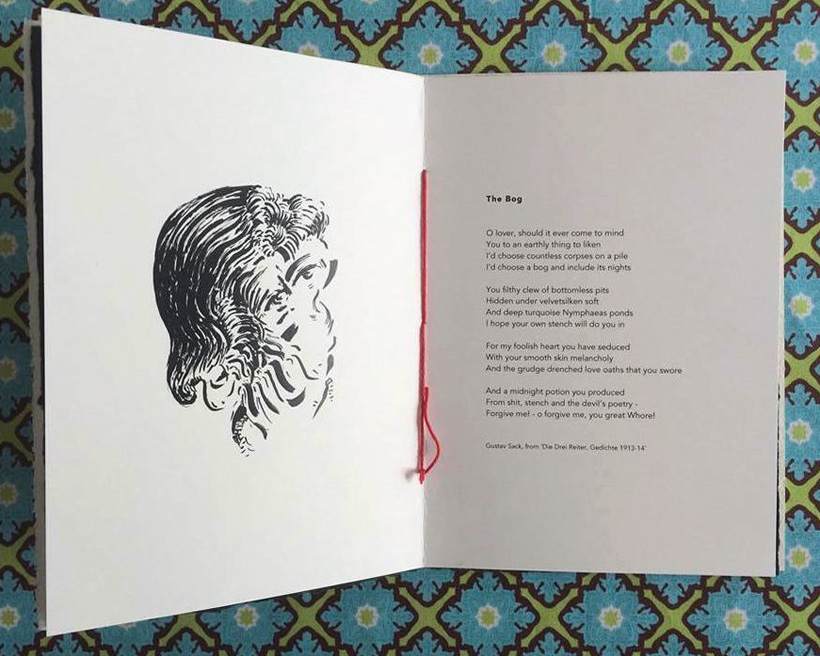
Author: Gustav Sack
Publisher: Sea Urchin
Year: 2015
Original title: Das Moor (1913-1914)
Language: English
Translation from German & illustration : Ben Schot
4 pages laser printed on 200 gr paper, flyleaf of Japanese hand dipped paper
Size: 210 x 150 x 3 mm
Binding: red thread pamphlet stitch
Cover: watercolour on 300 gr. Saunders Waterford
Limited, numbered and hand made edition of 15
Gustav Sack (1885-1916) grew up in the German village of Schermbeck, close to the Dutch border and the industrial Ruhr district. He attended the grammar school of the nearby town of Wesel and did German Studies and Natural Science at the universities of Greifswald, Münster and Halle before dropping out in 1910. Sack developed an interest in literature during his grammar school days, when he discovered Shakespeare, Shelley, Byron, Schopenhauer and many others and started writing himself. His wild and intoxicated student days were reflected in his first novel ‘Ein verbummelter Student’, written in 1910 when Sack was 25 years old. Despite Sack’s high expectations the novel was rejected by a Munich publisher that same year, but determined to pursue a career as a writer, Sack moved to the Bavarian capital anyway in 1913.
 In Munich – in those days a mecca of German bohemianism – Sack and his future wife Paula Harbeck got in touch with the literary avant-garde and the first generation of expressionists. But the outbreak of World War I and his inevitable mobilisation made anti-militarist and anti-nationalist Sack decide to leave the country and take refuge in Switzerland. Being treated as a deserter by both the German and Swiss authorities, finding his financial support cut completely by his family and being separated from Paula, whom he had just married, left Sack financially and emotionally bankrupt. He returned to Germany in 1914, reported to the military authorities and was sent to the trenches of the Somme front a month later. In poems and an extensive correspondence with Paula he documented the insanity of the trench war for the next year and a half. After having been arrested for misconduct and insubordination, Sack was transferred to the psychiatric ward of a military hospital, where he stayed for a while and then was reunited with his wife. In 1916 they moved back to Munich. Just as Sack had reconnected with the avant-garde circles there and Paula had managed to raise interest in his work, Sack was sent to the front again – this time to Romania – where he was killed in action a couple of weeks later. None of Sack’s works saw publication during his lifetime, but through the efforts of Paula they were published posthumously and then were acclaimed by leading authors such as Thomas Mann and Theodor W. Adorno.
In Munich – in those days a mecca of German bohemianism – Sack and his future wife Paula Harbeck got in touch with the literary avant-garde and the first generation of expressionists. But the outbreak of World War I and his inevitable mobilisation made anti-militarist and anti-nationalist Sack decide to leave the country and take refuge in Switzerland. Being treated as a deserter by both the German and Swiss authorities, finding his financial support cut completely by his family and being separated from Paula, whom he had just married, left Sack financially and emotionally bankrupt. He returned to Germany in 1914, reported to the military authorities and was sent to the trenches of the Somme front a month later. In poems and an extensive correspondence with Paula he documented the insanity of the trench war for the next year and a half. After having been arrested for misconduct and insubordination, Sack was transferred to the psychiatric ward of a military hospital, where he stayed for a while and then was reunited with his wife. In 1916 they moved back to Munich. Just as Sack had reconnected with the avant-garde circles there and Paula had managed to raise interest in his work, Sack was sent to the front again – this time to Romania – where he was killed in action a couple of weeks later. None of Sack’s works saw publication during his lifetime, but through the efforts of Paula they were published posthumously and then were acclaimed by leading authors such as Thomas Mann and Theodor W. Adorno.
Originally called ‘Das Moor’ and posthumously published in ‘Die drei Reiter, Gedichte 1913-1914’ in 1958, ‘The Bog’ is a dark, cynical, but at the same time humorous expressionist poem, a product of its time but more than that a timeless love poem, drunk and foul-mouthing on a mixture of tradition, modernity, and strong imagery. The poem was translated into English and illustrated by Ben Schot. ‘The Bog’ comes published as a slim chapbook that was cut, folded, watercoloured and stitched by hand in a limited edition of 15 copies.


